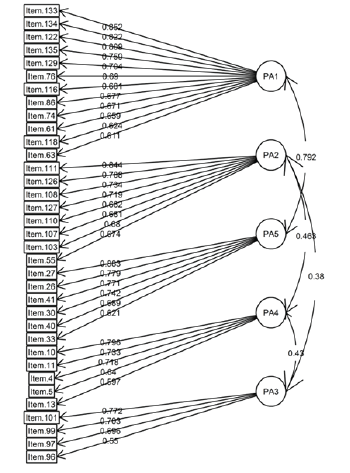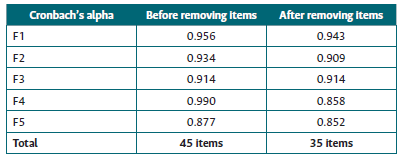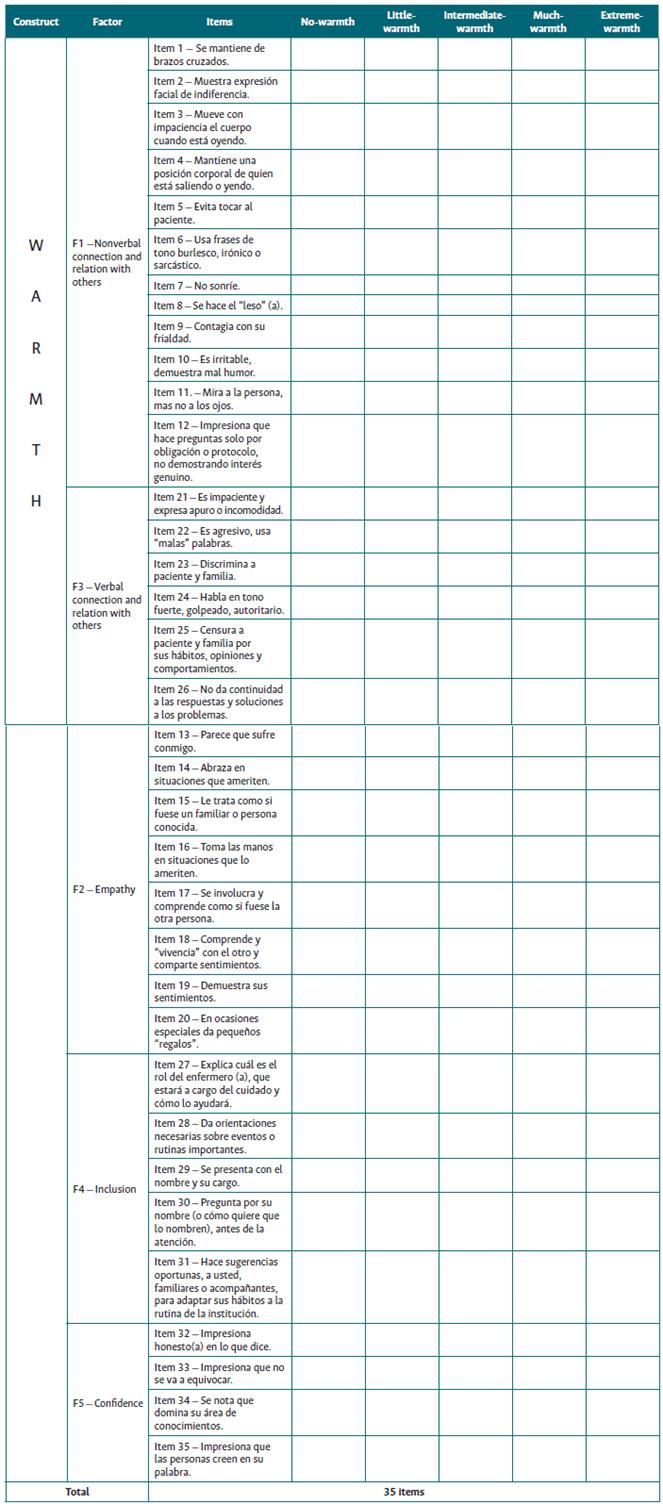Introduction
In nursing, interpersonal skills may be predictors of satisfaction since they are a relevant component of nurses' skills 1. Soft skills in nursing care are important attributes that may be even more relevant than care, the technical component of user satisfaction 2. Warmth is an important attribute in health care that is also a relevant factor and a decoder of patients' communication 3. However, this attribute has been little explored in health and nursing care. Warmth holds an incredibly special place in life because it works throughout the entire spectrum of human experience. A positive family context, characterized by warm relationships promotes the positive development of children towards adolescence 4. Warmth also helps us be healthy human beings on many distinct levels 5.
Warm behaviors have strong impacts on the measurement of users' satisfaction 6. For patients, kindness, smiles, affection, and tenderness have greater relevance than the technical component of care 7. As an example, respect, supportiveness, communication, and faithfulness are among the most frequently identified personality traits of "good nurses" 2.
A nurse's warmth and professional competences are fundamental aspects perceived by the patient with a compensatory association between them. Both dimensions are essential in social judgment and show that the appreciation in either of them influences the way a person judges another 8. Therefore, warmth and competence predict an increase in helping intentions 9.
When studying warmth measurement in the nursing practice, no instruments were found. Despite the relevance of this important dimension, there is not enough evidence to highlight this value in nursing care nor a consistent way for its measurement.
With the above in mind, the objective of this study was to construct and validate the Nursing Warmth Scale (NWS) through the development of a standardized measurement of nursing professionals' warmth, from the perspective of patients, and identify the behaviors and factors associated with this concept.
Materials and methods
This is a methodological and psychometric study on the construction of a psychosocial construct measurement scale using the psychometric reference.
A study was conducted to build and validate the NWS 10. The psychosocial construct was formulated using the psychometric test reference 11 developed in three phases: theoretical, empirical, and analytical 12. A theoretical review and interviews with patients and professionals were included, as well as an assessment with a panel of 10 judges 13.
The conducted procedures included an integrative review, following the recommendations for this type of studies 14 included in works previously published by the authors 15. Additionally, interviews with patients and nurses were performed with the aim of broadening the understanding of concepts and behaviors around the feeling of warmth.
The authors developed the construction of items, during a first phase, with the results of an integrative review that consolidated the construct "Nursing-warmth" and a set of variables related to this concept 15, and with the information provided by the qualitative study developed to evaluate the latent variable and increase the pool of items. The construct of warmth is then understood as "The ability to establish and maintain a close host relationship that demonstrates tenderness, trust, the affection, and love, through both verbal and nonverbal behaviors, in such a way that it means a pleasant experience for the other person" (15, p. 106). After the formulation of the construct, warmth-related behaviors were identified and then grouped into 2 major categories: 70 verbal and 23 non-verbal behaviors.
At this stage, interviews were conducted with patients and nurses from medical units at a public hospital and private clinic, inquiring about behaviors mentally associated with warmth. Twenty-three patients with 3 days of hospitalization and 25 nurses were interviewed. The results about related behaviors derived from the analysis of the interviews 16 were incorporated into those derived from the theoretical phase, resulting in a total of 154 items.
The criteria used for reducing items from the scale was to remove those that appeared more than once. In cases where items had both negative and affirmative statements, the affirmative item was chosen. As a result, the number of items was reduced from 154 to 136.
Content validation was performed with the help of 10 expert judges, following the approaches by Mary Lynn and other authors 17. The panel was selected based on inclusion criteria, which considered experts' educational background and experience in different disciplines. Finally, six nurses, two psychologists, a civil engineer, and a social worker were selected, all of them with expertise in user satisfaction.
The group of experts performed the semantic, grammatical, and syntactic equivalence analysis of items and provided recommendations for a better understanding of these elements 17. Items were evaluated using an instrument designed for this phase of the process, which assessed their relevance, pertinence, clarity, and essentiality.
The scores assigned to each category were determined, ensuring the representation of the definitions and semantics in Spanish for each extreme of the scale. The criteria no warmth to absolute warmth was used.
The harmonization of items and standardization of the instrument was conducted in a pre-testing phase, which included a pilot test with a sample of 25 patients to check item comprehension and compliance and to collect suggestions. Only patients with 3 days or more of hospitalization were included in the sample.
Sample
Following content validation, the internal structure of the scale was tested in a sample of 476 individuals. To obtain the sociodemographic data of participants, a section that gathered information on gender, age, diagnosis, days, and hospitalization unit was incorporated at the beginning of the instrument. The sample size was calculated according to the number of items in the scale and the statistical methods employed 18. Therefore, the ratio of the number of items and the expected sample size should range from 1:5 to 1:10, with an initial sample of at least 150 individuals 19. To ensure heterogeneity, convenience sampling was used for selecting the participants of the research, who were patients hospitalized in the units of medicine and surgery in a public hospital and two private clinics. The inclusion criteria mentioned above was also considered during the sampling and the selected individuals were personally contacted for data collection. After an induction process, the instrument was self-administered, granting participants the possibility of answering questions at the time of the scale removal, respecting their legal rights and duties.
Statistical procedures
The objective of this analysis was to evaluate the validation of the internal structure of the NWS. Thus, exploratory factor analysis (EFA) was performed in order to analyze the validity and accuracy of the battery of 136 items. The explanatory ability of the factors was also analyzed, examining the proportion of the variance explained by each of them. Finally, the reliability of the preliminary scale was estimated. Initially, the matrix of variables was built for 476 subjects and 136 items, and the data were grouped and coded. Totals, averages, standard deviation, and inferential statistics were used for quantitative data, while qualitative information was grouped and categorized by absolute and percentage frequencies.
The number of factors was determined using the common factor and rotation matrix methods. In the case of factor number determination, factorial loading, the Guttman-Kaiser criterion, or self-worth 20, the root mean square error of approximation (RMSEA), the Tucker-Lewis index (TLI) 21, and the fit incremental goodness index were used. The RMSEA measures the distance between two correlation matrices estimated by the factors. Finally, consistency was measured through Cronbach's alpha 22.
Statistical analysis
Statistical analysis involved EFA. For the removal of redundant items that shared the same variance, we applied a corrected homogeneity index with item-total correlation and without the scanned items 23. Cronbach's alpha was affected when removed items were analyzed, choosing the item with the best factor load or that that was qualitatively more important. Keeping at least 3-4 items by factor was ensured 24. Finally, we conducted a parallel analysis and carried out the rotation of factors (Oblimin) 25.
The graphic verification of factors was determined using the Scree-Test (eigenvalue). The self-worth value indicates the total amount of variance that explains each factor for grouped variables, thus determining the number of factors to be retained. In Likert-type scales, greater than 5 points with polytonic items, the use of the product-moment correlation matrix is recommended 26.
The analysis of the cumulative explained variance, necessary to interpret the proportions that justified each factor, plus that of the variance for the whole matrix of the final solution was performed using the "R" program (The R-Project for Statistical Computing, v3.1.3). To obtain the best solution for an appropriate model, the resulting items within each factor were analyzed qualitatively. Items describing similar behavior were compared with through RMSEA, choosing those who were the least harmful by internal consistency.
The study was approved by the Scientific Ethics Committee of the Universidad de los Andes (Chile) and the ethics committees of the respective institutions of the health and regional government (Concept Consubstantiated of Committee for Ethics in Research. August 26, 2014. CAAE: 34554514.6.0000.5392. Concept number: 772.008).
Results
Sample characterization
As shown in Table 1, the sample was comprised of approximately the same share of women and men (48 and 51%, respectively). Among participants, 75% belonged to the private health system and 18% to the public system. The average age was 47.3.
Table 1 Sample description: socio-demographic characteristics and hospital internment
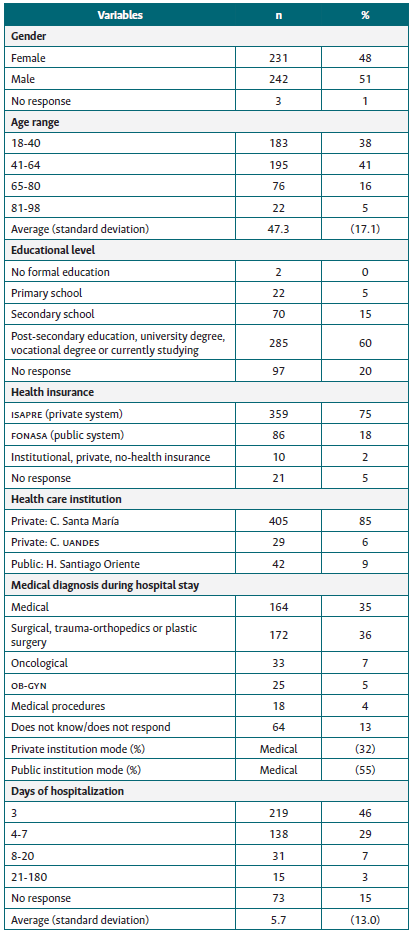
Source: authors.
As for their educational level, 60% of the participants reported a high level of education. Besides, 83% claimed to live with their family or accompanied and 70% were hospitalized by a medical or surgical diagnosis, with an average of 5,7 days of hospitalization. On average, 80% of the patients had previously been hospitalized three times.
Analysis of load factor
The load factor matrix presented in Table 2 was the ultimate solution after the analysis of the 4 adjustments performed to the model. The path-diagram charts, in a more understandable way, the relationships between variables and the ordered loads and hypothetical relationships for each factor; for example, Factor-5 in the original diagram corresponds to Factor-3 in the final solution (Figure 1). Similarly, the self-value graph criterion clearly shows 5 factors, as depicted in Figure 2.
Table 2 Factor loadings matrix with the final items
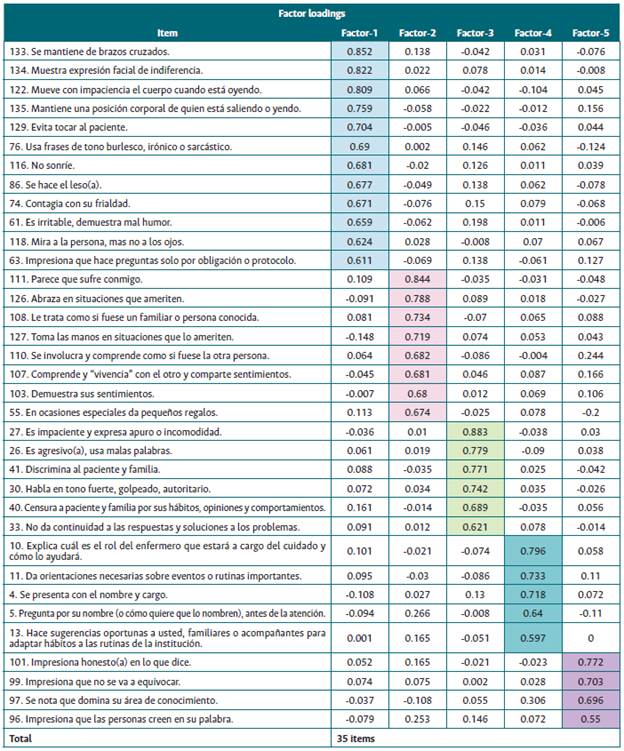
Note: Analysis of load factor. Items are expressed in their original language.
Source: authors.
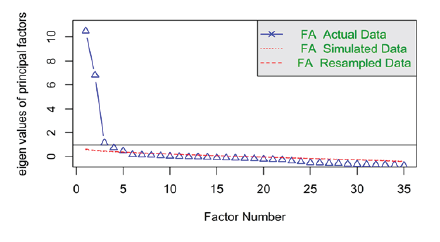
Source: authors, using R software.
Figure 2 Self-values in the final solution after parallel analysis
Factor analysis results show that warmth, according to this validation sample, is composed of 5 factors. The synthesis of the extracted factors is shown in Table 3.
Each factor showed results of high internal consistency, measured through Cronbach's alpha statistical (F1: 0.94; F2: 0.90; F3: 0.91; F4: 0.85; F5: 0.85). The load factor of the 35 items exceeds 0.55 points. The literature recommends that studies with samples exceeding 350 subjects select the items with loads over 0.30 26. Five factors explained 61.6% of the variance, being 20% explained by Factor-1. Items with a lower RMSEA index were chosen to be removed (Table 4). The definitive solution was set at 5 factors and 35 items. Finally, the TLI improved from 0.880 to 0.901.
Magnitude of warmth
Patients were asked to consider the magnitude of warmth using the words nothing/little/intermediate/much/extreme by means of an adapted 7-point Likert scale. The final composition of the scale is described in Table 5.
Discussion
The objectives of building and validating the NWS from the perspective of patients and identifying behaviors associated with warmth were fully achieved. In doing so, this study fills an existing gap regarding the meaning of warmth in nursing, since this feeling brings together interpersonal nursing skills that strongly affect patients' perceptions regarding the care experience 1,2. Interpersonal skills have immense value in building bonds with the patient, with warmth or a human tone, being a desirable attribute of nurses in providing humane and safe care 27.
The "nurse warmth" construct and the items that comprise it were initially generated from a literature review, achieving a methodological integration of the concept and its dimensions. The attributes of nurse warmth that have been defined in the current literature, such as closeness, expression of affection, effective communication, respect, and the nurse-patient bond 28, go in line with our proposal, since we address connection, empathy, inclusion, and confidence, all of which contribute to strengthening the relationship and bonds between nurses and their patients.
The review by the group of experts allowed validating the content of the scale, thus adjusting the degree to which the analyzed items represent the warmth construct and categorizing verbal and non-verbal behaviors with a relevant meaning in the dynamic and fluid communication with the patient, which is crucial to generate a reliable relationship in the care process 29.
After the analysis by experts, the qualitative phase, and the internal structure analysis, we generated the NWS with 35 items reduced into 5 factors, with factorial loads that exceed 0.55 and represent 61% of the total variance 10.
The NWS reflects warm behaviors associated with the caregiving praxis, which has in turn a humanizing nature when providing nursing care with warmth 30. The presence of warm behaviors in the care provided by nurses not only contributes dynamically to bond formation, but also has positive results in the treatment of patients and can contribute to 85% of the therapeutic effect 31.
Factor-1 (Nonverbal-Connection) has items with a high factorial load that mostly describe the absence of warmth, such as Does not smile or looks at the person, but not into the eyes, so that non-verbal communication that favors relational bonds, such as smiling and eye contact 32, is more relevant in their absence, possibly because it is expected. The exchange of messages must contain codes that could be understood and culturally accepted, being the non-verbal component an effective tool to establish contact with patients.
Factor-2 (Empathy) includes items related to the definition of empathy in nursing: "The ability to understand the experiences, concerns and perspectives of another person, added to the ability to communicate this understanding" (33, p. 121). For example, item 13 (It seems that he suffers with me) and item 17 (He gets involved and understands as if he/she were the other person) denote the nurse's ability to perceive and understand the patient from the emotional dimensions of empathy 33.
The literature confirms that when nursing care goes beyond the biological, empathy becomes a basic need. However, nurses are empathic in contexts that encourage such occurrence, demonstrating that empathy grows with constant reinforcement 34. In this way, the NWS contributes to the identification, understanding and establishment of warm behaviors that represent empathy, thus being able to develop a kind of training that favors the understanding, establishment, and permanence of these care behaviors in health institutions.
Factor-3 (Verbal-Connection) includes items that are related to the importance of verbal communication, including words and voice tone, i.e., item 24 (Speaks in a loud tone, authoritarian), which has a relevant meaning on the message, especially in the conception of the social-voice that incorporates the receiver's interpretation of the acoustic properties of the voice, powerful cues when forming social impressions 35.
For the person receiving care, verbalization reduces tension and anxiety, helps in coping with the experience of the disease, and generates a form of trust, thus verbalizing this feeling will contribute to the healing process. For the nurse, verbalization enables to identify the needs of the sick person 29. Overall, identifying the warm behaviors grouped in this factor contributes to the understanding of the person.
Factor-4 (Inclusion) incorporates behaviors related to induction to the healthcare environment, which implies informing patients about who nurses are and what they do, giving relevance to the first contact that generates a more human therapeutic relationship. In Chile, these aspects are legally regulated, stating that patients have the right to receive understandable information and be treated with kindness 36. The empathic relationship also contributes to the approach and inclusion of the patient within the health area 31.
Finally, Factor-5 (Confidence) reasserts the models of warmth and competence impressions 8. Confidence is the basis of social practices and is intricately linked to professional competence 8.
Knowing warmth-related behaviors associated with trust will allow nurses to show how competent they are in their area without neglecting the warm components of the relationship, strengthening the balance between warmth and competence.
Since warmth influences patient satisfaction 6, establishing a level for this construct in order to satisfy the user can be especially useful. Identifying the factors associated with nursing warmth will allow for improved care management, research, and education. However, some cultural aspects must also be considered, since unaccepted behaviors related to personal contact vary among cultures. Therefore, a cross-cultural adaptation is required to be applied in other linguistic contexts 37.
In this study, it was not possible to achieve 10 subjects per variable, as expected 18. However, an arrangement with high factor loadings was obtained with indices and excellent reliability. To conclude, other methodological contributions should be incorporated in the future, such as the item-response theory.
Conclusions
The NWS is the first scale that measures warmth in the nursing discipline. This tool shows evidence of validity and reliability for the Chilean population and provides the discipline with a new instrument that addresses a relevant dimension for nursing.
Our study provides a scale that incorporates a qualitative phase in its development that involved the contributions of professionals and users for the construction of items, represented in behaviors, which were validated by experts according to the recommendations regarding content validation.














